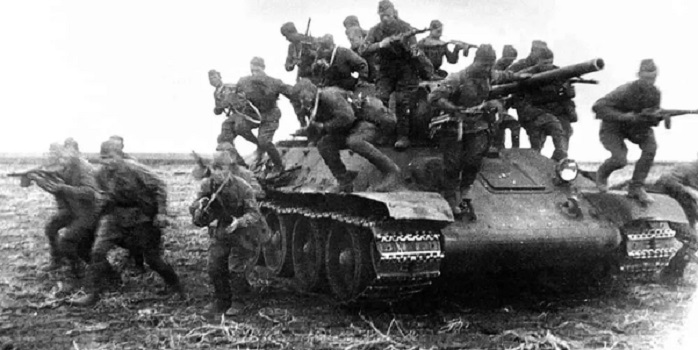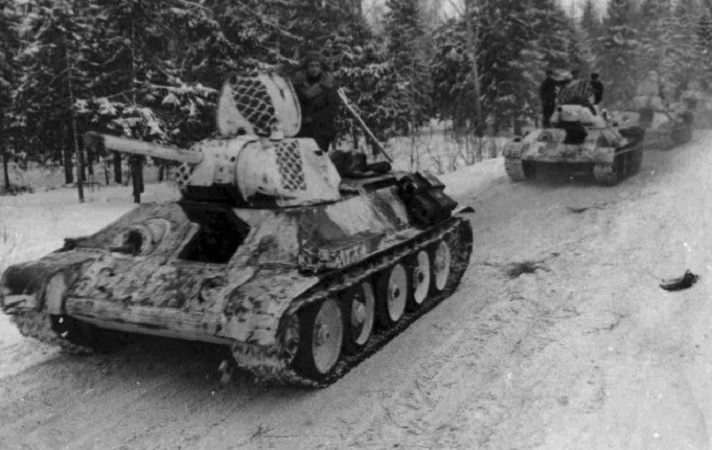● ● ●
The Red Army was
a pioneer in the field of mechanized warfare, organizing its
first large armored units as early as 1932. (The first three
panzer divisions of the German Army were set up in 1935.)
These division-sized units, initially called mechanized
corps and later tank corps, had three tank brigades and an
array of support units. The tank brigade had four tank
battalions (204 tanks total), a mechanized reconnaissance
battalion, a motorized rifle battalion and a motorized
combat engineer regiment. Tank brigades organic to the tank
corps were equipped with the BT-series or T-26 light tank
(45mm gun)—over 600 in all. There were also a number of
separate tank brigades and some of these had the T-28
infantry tank (76.2mm gun).
The prewar tank corps, like the
early panzer division and the early British armored
division, had too many tanks and insufficient infantry.
During the Red Army's 1939 invasion of eastern Poland they
proved unwieldy, taking up far too much road space. The
obvious solution was to reduce their size but instead it was
decided to disband the tank corps altogether and
distribute the tank brigades among the rifle (infantry)
corps. Characteristically, politics played a role in this
decision. The development of large mechanized units was
associated with the group of military leaders headed by
Marshal Mikhail Tukhachevsky—the officers condemned and
executed on trumped-up treason charges in 1937. Marshal
Kliment Voroshilov, a Stalin crony who’d played a role in
Tukhachevsky’s downfall, was People’s Commissar of Defense
in 1939 and he had been opposed to the dead man’s military
theories. It was at Voroshilov’s instigation that the tank
corps were disbanded.
However, the combat debut of the
German panzer divisions in Poland inspired second thoughts. Voroshilov, whose poor performance as commander during the
Winter War with Finland had angered Stalin, was replaced by
Marshal Semyon Timoshenko in May 1940. On his initiative the
Red Army began to set up mechanized corps of a new type.
They were very similar to the German motorized corps, with
two tank divisions and one mechanized division, the latter
in effect a light armored division. But this
corps/divisional organization proved too sophisticated for
the Red Army, which lacked sufficient technical specialists
to make it workable and, thanks to the 1937-38 purge, was
short of trained staff officers and competent
commanders. Moreover, many of the mechanized divisions were
so in name only—this thanks to a critical shortage of motor
vehicles. Nor were there enough tanks to fully equip all
armored units, a fifth of which of which actually had none
at all.

Red Army tank rider
infantry, armed with submachine guns, dismount from a
T-34-76. (Red Army photo)
By the time of the German invasion
(22 June 1941) there were 29 mechanized corps at least
nominally in existence and these were largely destroyed in
the opening battles. In the subsequent reorganization of the
Army, the tank brigade was revived in a simplified and
smaller form. In its new version it was really was an
armored battalion with an infantry contingent. Gone were the
reconnaissance and engineer units, and there were only two
tank battalions with fewer than fifty tanks between them.
The motorized rifle battalion was also reduced in size. At
first these tank brigades were thrown together using
whatever troops and weapons lay ready to hand but by
early-1942 their organization had been standardized. In late
1941 and early 1942 some tank brigades and independent tank
battalions were equipped with British tanks acquired through
Lend-Lease. Most were Matilda Mark II and Valentine Mark II
infantry tanks, and during the Battle of Moscow (winter
1941-42) they made up some 30% to the Red Army's front-line
tank strength.
Also in late 1941 a start was made
on the recreation of the tank corps, albeit on a smaller
scale than before. The first four had two tank brigades and
whatever infantry and support units that could be scraped
up. By the end of the year, however, their organization was
standardized with two tank brigades and a motorized rifle
brigade. Tank strength was 20 KV-1 heavy tanks (76.2mm gun),
40 x T-34 medium tanks (76.2mm
gun) and 20 x T-60 (20mm gun) or T-70 (45mm gun) light
tanks. Originally it had been intended to equip the tank
corps exclusively with KV-1s and T-34s, but it was some time before
the factories that had been hastily evacuated from the
threatened areas of the USSR could produce them in
sufficient numbers. So light tanks—the inadequate T-60 and
the only marginally better T-70—had to be substituted. The
motorized rifle brigade had three battalions plus support
units. The motorized rifle battalion had one platoon armed
exclusively with submachine guns, considered the ideal
weapon for infantry fighting in cooperation with tanks. There troops often rode into action on the
tanks they supported. Later in the war, whole companies were
armed with submachine guns.

T-34-76 tanks in the
winter of 1941-42. More than 57,000 T-34s were produced
during the war (Red Army photo)
With just 80 tanks and 5,600 men,
the new tank corps proved to be too small. In early 1942,
therefore, they received a
third tank brigade and a motorcycle reconnaissance
battalion. By late 1942 a heavy mortar regiment with
36 x 120mm mortars, a
self-propelled artillery
regiment—really an armored assault gun battalion—and a light
antiaircraft battalion with 37mm guns had also been
added. The 120mm mortar partially compensated for the lack of field artillery; the SP artillery regiment
provided direct fire support for the tanks and infantry.
Thus by 1943 the tank corps was remarkably similar to the
US Army’s “light” armored division: Both had three tank
battalions, three motorized infantry battalions and a
mechanized reconnaissance battalion. But the US division
also had three battalions of self-propelled artillery—and
this was genuine field artillery, capable of indirect fire
and of operating under centralized control. The tank corps’
most glaring deficiency was the absence of such field
artillery—unavoidable since the Red Army lacked sufficient
trained personnel to provide it. Otherwise, however, the
tank corps was a well-organized formation with a heavy punch
relative to its size. As the war progressed it grew somewhat
larger and received more and better equipment, much of it
via Lend-Lease.
In total the Red Army raised 31
tank corps during World War II, though though only 25 saw
action in that form, some being converted into
mechanized
corps. There were also numerous separate tank brigades
that were used either to reinforce mobile formations or
support rifle divisions, particularly on the attack. They
could not be used to form additional tank corps since
qualified personnel for the necessary support units were
unavailable. The existing tank corps, however, were
gradually enlarged with additional units such as rocket
artillery regiments, self-propelled artillery regiments and heavy tank regiments.
● ● ●